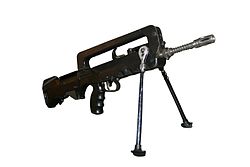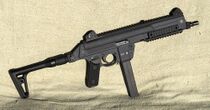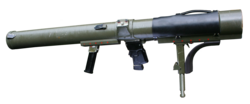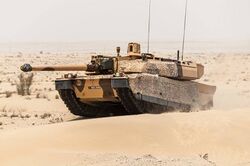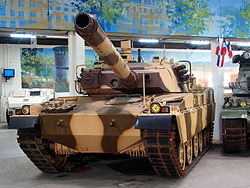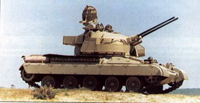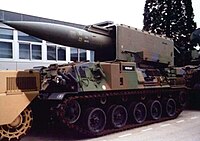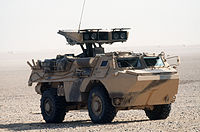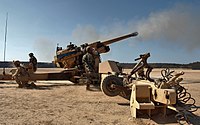Talaharan Army Corps
| UCDF Army Corps | |
|---|---|
| ⵜⴰⴼⴻⴽⴽⴰ ⵏ ⴰⵎⴻⵏⵏⵓⵖ Tafekka n Amennuɣ | |
 Roundel of the Talaharan Army Corps | |
| Active | Since 1854 |
| Country | |
| Type | Army |
| Role | Land warfare |
| Size | 100,080 |
| Part of | United Communes Defense Forces |
| Colours | Black Red Dark sand |
| Engagements | |
| Commanders | |
| Commander-in-Chief | Executive Council |
| Executor of Defense | Taos Jebar |
| Defense Committee Senior Representative | General Kahina Hamastan |
| Defense Committee Enlisted Representative | Sergeant Karim Jurgutha |
The Talaharan Army Corps (Takelat: Tafekka n Amennuɣ; ⵜⴰⴼⴻⴽⴽⴰ ⵏ ⴰⵎⴻⵏⵏⵓⵖ), officially the United Communes Defense Forces Army Corps, is the professional land warfare component of the United Communes Defense Forces. It is directly subordinated to the Defense Committee, where it is represented by General Kahina Hamastan and Sergeant Karim Jugurtha.
The Army Corps has over 100,000 active service members. There is no reservist force. Talahara does not practice conscription and all members of the Army Corps are professional, full-time soldiers. In addition, administrative staff from the Black Guards and civilian agencies fulfill supplemental work.
In its current incarnation, the Talaharan Army Corps has seen few deployments. In terms of major deployments, however, it has a strong history of success and rapid response. Traditional Talaharan land doctrine calls for large-scale, rapid advances with multiple units operating in tandem to capture open ground quickly, with a second line to move into key target areas once supply lines have been overwhelmed. These tactics have frequently led to victory in the geography of Northern Scipia, and have been developed upon in the decades since Talahara's last major conflict.
History
After the Talaharan Civil War concluded in 1838, the Central Commune Army was disbanded to prevent a single armed and organized group from exerting undue influence on the new government. The Central Army was composed primarily of defectors from the monarchist cause during the war who had served professionally in the Royal Talaharan Army. The subject of national defense was thus left entirely to the Black Guards. While the Talaharan Navy Corps was formed in 1845 to directly address littoral defense, land warfare remained entrusted entirely to local militias, albeit well-trained, battle-hardened, and numerous.
In the years following the revolution, additional security threats were cause for concern for the nascent syndicalist republic, including the threat of monarchist Yisrael and growing civil unrest in neighbouring Tyreseia. Furthermore, the Yisraeli foothold in the Protectorate of Taršiš, seized from the country's west, could not be reclaimed. In 1854, the Supreme Legislative Council approved the creation of a land-based professional fighting force to supplement the Black Guards. In order to curb the potential influence of a uniquely armed and organized group, the size and operation of the force were placed under the purview of the Supreme Council and the Executive Council. The Navy Corps was subsequently subjected to the same controls.
The new Talaharan Army Corps was formed initially out of dedicated Black Guard veterans who chose to leave their primary industries for a full-time military career. This deprived the Black Guards of many of their more experienced members and materials but assured an experienced core to lead and train the future army. The initial size was capped at 40,000 members, but only 25,000 to 30,000 members enlisted within the first three years. Despite political pressure and concerns over the continued occupation of the Protectorate of Tarshish, military leaders in the United Communes considered a military invasion unfeasible.
In 1879, the Talaharan Army Corps saw its first deployment in support of the Sidduni Coup of the Tyreseian government. Only two regiments took part in the two-year operation, but Talaharan doctrine was refined by live combat experience. In the aftermath of the coup and Azmelqart Sidduni's dissolution of his armies to prevent further coups, the Talaharans assisted in training the Tyreseian Workers' Naval Infantry Service in land warfare.
Forty years later, the next major campaign involving the Talaharan Army Corps took place. In the aftermath of the Second West Scipian War, which was fought between Sydalon and Yisrael, the weakened state of the latter presented an opportunity for the United Communes of Talahara. While Tarshish remained reinforced, it became the subject of a special intelligence campaign to undermine Yisraeli influence.

In 1919, the Talaharan Army Corps issued a surprise declaration of war against the Kingdom of Yisrael and rapidly launched an invasion in the south, seizing control over the Amara region, known as the Timna Strip in Yisrael. The Amara region is an oil-rich region with significant Kel Hadar and Kel Tenere populations. Unable to mount an effective counter to the invaders and with additional Army and Black Guard forces holding a firm line over the rest of the border, Yisrael was forced to concede the region after a short conflict.
During the First Partisans' War and the Great Ottonian War, Talahara provided material support to socialist factions. Geographic barriers prevented full-scale deployments, but Army Corps members were explicitly granted leave to volunteer abroad and permitted to take equipment with them. Between three and five thousand Talaharans served in volunteer battalions in Belisarian conflicts in the 1920s and 1930s.

The Liberation of Taršiš took place in 1951 in the aftermath of the Third West Scipian War. The invasion, supported by local dissidents and protestors, was the first combined arms operation of the UCDF. Naval landings and aerial support allowed Talaharan soldiers to rapidly advance on major military and government targets. The Protectorate's governors were captured and imprisoned but released to Yisrael in the peace process that soon followed. The Protectorate of Tarshish was formally dissolved before the end of 1951 and the region of Taršiš was restored to Talahara after over 100 years of occupation.
Structure and organization
| Hammer Arm | Spear Arm | Sword Arm | |||
|---|---|---|---|---|---|
| Division | Units | Division | Units | Division | Units |
| 1st Division |
|
4th Division |
|
Special Intelligence Division |
|
| 2nd Division |
|
5th Division |
|
9th Division |
|
| 3rd Division |
|
7th Division |
|
12th Division |
|
| 6th Division |
|
8th Division |
| ||
| 10th Division |
|
11th Division |
| ||
The Talaharan Army Corps is composed of 56 regular force regiments divided into ten mixed divisions. These divisions are divided between two arms of the Army Corps. The Hammer Arm (Takelat: Selaḥ n Maṭraqa) has a greater proportion of tanks and mechanized infantry. The Spear Arm (Takelat: Selaḥ n Zaɣaya) has a greater proportion of light infantry. The two arms support the traditional attack-in-depth doctrine of the Talaharan Army Corps, though in practice ad hoc combat groups are formed with elements from different divisions according to operational necessity.
A third arm, the Sword Arm (Takelat: Selaḥ n Ajenwi), includes the Army Corps's three special forces divisions. These include airborne infantry units, naval infantry units, and the Special Intelligence Division which provides signal and military intelligence for all four branches of the UCDF. Units from the Sword Arm rely on support and resources from other branches of the Defense Forces, including deployment via Air Corps and Navy Corps assets. Several units within the Sword Arms answer directly to the Defense Committee and many of their activities and programs are classified.
The Army Corps has three independent elements in addition to the ten regular force divisions and three special forces divisions. The Army Corps Central Command Division is the central administrative unit of the Army Corps, based with the 1st Division in Maktarim. The Command Division includes the headquarters of the Army Corps, the Amenities and Human Resources Department, the Central Supply Department, the UCDF Security Department, and the Officers' Training Centre.
The Army Corps Commissariat Division is a liaison body between the Army Corps and the Black Guard Corps. The Commissariat Division's members maintain a permanent position in a regular force division in addition to the Commissariat Division. Army Corps members with sufficient seniority go on rotations through the Commissariat Division to train and advise Black Guard units throughout the country.
The Medical Services Division provides medical and ambulatory services in the Army Corps. The MSD includes both professional Army Corps medical professionals and seconded Black Guard members who ordinarily practice medicine. Air and ground ambulance services are assigned to training and combat missions based on operational necessity. The MSD also provides training for regular force field medics.
The basic fighting unit of the Army Corps is the ad hoc Strategic Group (Takelat: Agraw Asudesi), commanded by an Adjutant-Colonel or a Vice-Colonel. A Strategic Group is typically based on a unit of three battalions, two of which are either infantry or tank battalions with a third battalion of the alternative. An infantry-based group is referred to as a Spear Group while a tank-based group is called a Hammer Group. The three main battalions are supplemented by a reconnaissance troop, an artillery battery, and a relief battalion of either infantry or tanks. Most divisions are equipped to form two Strategic Groups, though a few can assemble three. A Strategic Group with assigned air support from an Air Corps Wing is referred to as a Combined Arms Group.
A Strategic Group can be further divided into three Tactical Groups (singular, Takelat: Agraw Eɛqeli), each commanded by a Group Commander or an Adjutant-Colonel. Tactical Groups include three to four companies of infantry and tanks with minimal direct reconnaissance or divisional-level artillery support.
Equipment
Infantry equipment
| Personnel protection | |||||
|---|---|---|---|---|---|
| Model | Image | Origin | Type | Notes | |
| S120 | Combat helmet | Constructed from proprietary polyethylene fibres, special mounting and weight distribution system | |||
| S101 | Combat helmet | Constructed from proprietary polyethylene fibres, protects against fragmentation and pistol-calibre bullets | |||
| OX-TG99 | Gas mask | Includes a voicemitter, a drinking system, and ambidextrous filter mounting, filters up to 17 different agents | |||
| QK133 | Military camouflage | Six-tone multi-environment pattern | |||
| QK98 | Military camouflage | Three-tone desert pattern | |||
| Small arms | |||||
| Model | Image | Origin | Type | Calibre | Notes |
| M131 | Assault rifle | 6×45mm | New service rifle | ||
| M87A2 | Assault rifle | 7.5×35mm | Standard service rifle | ||
| MW134 | Battle rifle | 7.5×55mm | New battle rifle/DMR | ||
| M71A2 | Battle rifle | 7.5×55mm | Former service rifle, conversion to DMRs | ||
| B115 | Pistol | 9×25mm 10×25mm |
Standard service pistol | ||
| B59 | Pistol | 10×25mm | Standard service pistol | ||
| BM72A2 | Submachine gun | 9×25mm 10×25mm |
|||
| BY81 | Revolver | 9×25mm 9×33mmR |
Awarded after 10 years of service, limited use by special forces | ||
| MZ61A3 | Medium machine gun | 7.5×55mm | Section support and vehicle-mounted weapon | ||
| MZ61/67A2 | Heavy machine gun | 13.5×99mm | Vehicle-mounted weapon | ||
| M99/C3 | Sniper rifle | 9.5×70mm | Bolt-action, limited use by special forces | ||
| MW99 | Anti-materiel rifle | 13.5×99mm | Bolt-action, limited use by special forces | ||
| Personnel ordnance | |||||
| Model | Image | Origin | Type | Notes | |
| ABG99 | Infantry mortar | Fires 50mm high explosive or smoke grenades and flares | |||
| YRG87 | Rocket launcher | Fires 90mm HEAT or fragmentation grenades | |||
| YLG103 | MPATS/MPADS | Wire-guided, fires 137mm tandem HEAT missiles | |||
| TTG119 | MPATS/MPADS | Fire-and-forget and command-guided modes, fires 140mm tandem HEAT missiles | |||
| TX-YG105 | Automatic grenade launcher | Fires high-velocity 40mm grenades | |||
Vehicles
| Armoured fighting vehicles | |||||
|---|---|---|---|---|---|
| Model | Image | Origin | Type | Armament | Quantity |
| T104A2 Lion | 3rd generation main battle tank |
|
370 | ||
| T68/92A3 Caracal | 3rd generation main battle tank |
|
275 | ||
| T68/74A4 Serval | 2nd generation main battle tank |
|
215 | ||
| T104/C9 Lion II | 4th generation main battle tank (experimental) |
|
3 | ||
| TU130 Fennec | Reconnaissance vehicle |
|
292 | ||
| Engineering vehicles | |||||
| Model | Image | Origin | Type | Armament | Quantity |
| AK104 | Armoured recovery vehicle |
|
15 | ||
| AK68A2 | Armoured recovery vehicle |
|
30 | ||
| TT95 | Armoured vehicle-launched bridge | 3 | |||
| Armoured transports | |||||
| Model | Image | Origin | Type | Armament | Quantity |
| A117A2 Foxhound | Infantry fighting vehicle |
|
1,726 | ||
| A128 Wild Dog | Armoured personnel carrier |
|
120 | ||
| A85A2 Genet | Armoured personnel carrier |
|
1,156 | ||
| RA106 Wolf | 
|
Scout car |
|
233 | |
| RA94 Jackal | Scout car |
|
317 | ||
| Unarmoured vehicles | |||||
| Model | Image | Origin | Type | Notes | Quantity |
| R90 Sandpiper | Light utility vehicle | Primarily unarmed, can carry SAM systems or machine guns | 462 | ||
| R113 Gazelle | Medium utility vehicle | Materiel transport | 424 | ||
| R113 Ram | Heavy utility vehicle | Heavy materiel and troop transport, artillery platform | 1,734 | ||
Artillery
| Self-propelled artillery | |||||
|---|---|---|---|---|---|
| Model | Image | Origin | Type | Armament | Quantity |
| KT107 Aurochs | Howitzer |
|
96 | ||
| KT86T2 Bear | Howitzer |
|
33 | ||
| KH86 Adder | SPAAG |
|
45 | ||
| RH86 Skink | SAM platform | 42 | |||
| MB86 Caracara | SRBM platform | 10 | |||
| MT85 Hyrax | ATGM platform | 18 | |||
| MH0T2 White Night | SAM platform | 10 | |||
| RH107 Boa | MRLS |
|
24 | ||
| Towed artillery and mortars | |||||
| Model | Image | Origin | Type | Calibre | Quantity |
| K99 | Howitzer | 155mm | 90 | ||
| ABG70 | Heavy mortar | 120mm | 71 | ||
| ABG106 | Medium mortar | 80mm | 243 | ||
Ranks and insignia
Officer ranks
| OF-9 | OF-8 | OF-7 | OF-6 | OF-5 | OF-4 | OF-3 | OF-2 | OF-1 | |
|---|---|---|---|---|---|---|---|---|---|
| Insignia |  |
 |
 |
 |
 |
 |
 |
 |

|
| Takelat name | ⴰⵖⴻⵍⵍⴰ | ⴰⵖⴻⵍⵍⴰ ⴰⵏⵎazⴰⵍ | ⴰⵇⵍⴰⵍ | ⴰⵇⵍⴰⵍ ⴰⵏⵎazⴰⵍ | ⵜⴰⴱⴰⵟ | ⴰⵇⴻⴱⵟ | ⴰⵇⴻⴱⵟ ⴰⵏⵎazⴰⵍ | ⴰⵎⴹⵉⵇ | ⴰⵎⴹⵉⵇ ⴰⵎⴻkⵟⵓⵃ |
| Transliteration | Aɣella | Aɣella Anmazul | Aqlal | Aqlal Anmazul | Tabaṭ | Aqebṭ | Aqebṭ Anmazul | Amḍiq | Amḍiq Amekṭuḥ |
| Translation | General | Vice-General | Colonel | Vice-Colonel | Major | Captain | Vice-Captain | Lieutenant | Junior Lieutenant |
Enlisted ranks
| OR-9 | OR-8 | OR-7 | OR-6 | OR-5 | OR-4 | OR-3 | OR-2 | OR-1 | |
|---|---|---|---|---|---|---|---|---|---|
| Insignia |  |
 |
 |
 |
 |
 |
 |
 |

|
| Takelat name | ⴰⵇⴻⵔⵔⵓⵎⴻⵏⵣⴰⴷ ⵏ ⵇⵓⵎ |
ⴰⵇⴻⵔⵔⵓⵎⴻⵏⵣⴰⴷ ⵏ ⵜⴰⴱⴰⵟⵢⵓⵏⵜ |
ⴰⵇⴻⵔⵔⵓⵎⴻⵏⵣⴰⴷ ⵏ ⵜⴰⴽⴻⴱⴱⴰⵏⵉⵜ |
ⴰⵇⴻⵔⵔⵓⵎⴻⵏⵣⴰⴷ ⵏ ⵜⴰⴳⵔⴰⵡⵜ |
ⴰⵇⴻⵔⵔⵓ | ⴰⵙⴻⵔⴷⴰⵙⴽⵔⴰⴷ | ⴰⵙⴻⵔⴷⴰⵙⵙⵉⵏ | ⴰⵙⴻⵔⴷⴰⵙⵢⴰⵏ | ⵏⴻⵍⵎⴰⴷⴻⵏ ⵏ ⴰⵎⵎⴻⴽⵜⴽⴰⵡ |
| Transliteration | Aqerrumenzad n Qum |
Aqerrumenzad n Tabaṭyunt |
Aqerrumenzad n Takebbanit |
Aqerrumenzad n Tagrawt |
Aqerru | Aserdaskrad | Aserdassin | Aserdasyan | Nelmaden n Ammektkaw |
| Translation | Regiment Sergeant-Major |
Battalion Sergeant-Major |
Company Sergeant-Major |
Platoon Sergeant-Major |
Sergeant | Soldier III | Soldier II | Soldier I | Army Cadet |





